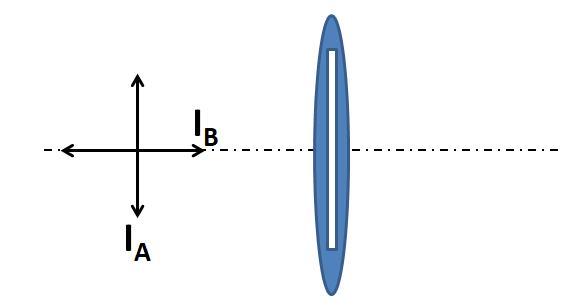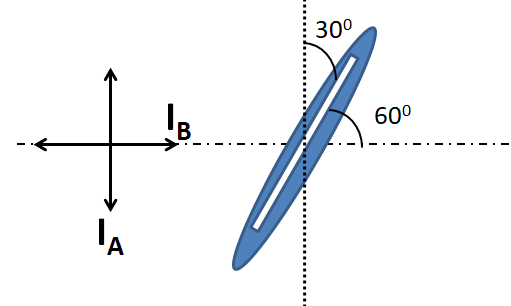
A Polaroid examines two adjacent plane polarised beams A and B, whose planes of polarization are mutually perpendicular. In the first position of the analyzer, beam B shows zero intensity. From the position a rotation of ${30^ \circ }$ shows the two beams have same intensity. The ratio of intensities of the two beams ${{\text{I}}_{\text{A}}}$ and ${{\text{I}}_{\text{B}}}$ will be:
(A) $1:3$
(B) $3:1$
(C) $\sqrt 3 :1$
(D) $1:\sqrt 3 $
Answer
122.7k+ views
Hint: To solve this question, we need to find out the initial position of the Polaroid with respect to the beams A and B. Then after the given rotation, we have to find its final position with respect to the both beams. Finally using the Malus law we can get the final answer.
Complete step-by-step solution:
We know that a Polaroid allows the components of the vibration of a light which are parallel to its axis. All the vibration components perpendicular to the axis of the Polaroid are restricted by the Polaroid. The intensity of the transmitted light as seen from the Polaroid is given by the Malus law as
$I = {I_0}{\cos ^2}{{\theta }}$..................(1)
From the above relation, we can see that the intensity of the transmitted light from the Polaroid is maximum when ${{\theta }} = {0^ \circ }$, and it is minimum for ${{\theta }} = {90^ \circ }$.
According to the question the initial position of the Polaroid is such that the beam B has zero intensity. So vibrations of the beam B must be perpendicular to the Polaroid axis. Since the planes of polarization of the beams A and B are mutually perpendicular, the vibrations of beam A must be parallel to the Polaroid axis as shown in the below diagram.

Now, according to the question, the Polaroid is rotated through an angle of ${30^ \circ }$, as shown below.

As we can see that now the Polaroid axis is inclined at an angle of ${30^ \circ }$ with the direction of the beam A, and at an angle of ${60^ \circ }$ with the direction of the beam B.
For beam A:
According to the question, the initial intensity of beam A is ${{\text{I}}_{\text{A}}}$. Also, the angle between the Polaroid axis and the beam A is equal to ${30^ \circ }$. Therefore substituting \[{I_0} = {{\text{I}}_{\text{A}}}\] and \[{\text{\theta }} = {30^ \circ }\] in (1) we get
\[{I_{\text{A}}}' = {I_{\text{A}}}{\cos ^2}{30^ \circ }\]..............(2)
For beam B:
According to the question, the initial intensity of beam B is ${{\text{I}}_{\text{B}}}$. Also, the angle between the Polaroid axis and the beam A is equal to ${60^ \circ }$. Therefore substituting \[{I_0} = {{\text{I}}_{\text{B}}}\] and \[{\text{\theta }} = {60^ \circ }\] in (1) we get
\[{I_{\text{B}}}' = {I_{\text{B}}}{\cos ^2}{60^ \circ }\].................(4)
According to the question, the two beams are appearing equally bright as seen from the Polaroid. This means that the intensities of the transmitted light of the beams A and B are equal, that is,
\[{I_{\text{A}}}' = {I_{\text{B}}}'\]
From (3) and (4)
\[{I_{\text{A}}}{\cos ^2}{30^ \circ } = {I_{\text{B}}}{\cos ^2}{60^ \circ }\]
\[ \Rightarrow \dfrac{{{I_{\text{A}}}}}{{{I_{\text{B}}}}} = \dfrac{{{{\cos }^2}{{60}^ \circ }}}{{{{\cos }^2}{{30}^ \circ }}}\]
We know that $\cos {30^ \circ } = \dfrac{{\sqrt 3 }}{2}$ and $\cos {60^ \circ } = \dfrac{1}{2}$. Therefore we get
\[\dfrac{{{I_{\text{A}}}}}{{{I_{\text{B}}}}} = \dfrac{{{{\left( {1/2} \right)}^2}}}{{{{\left( {\sqrt 3 /2} \right)}^2}}}\]
\[ \Rightarrow \dfrac{{{I_{\text{A}}}}}{{{I_{\text{B}}}}} = \dfrac{1}{3}\]
Thus, the required ratio is equal to $1:3$.
Hence, the correct answer is option 1.
Note: Always try to draw the diagram corresponding to this type of problem. This is done in order to be sure about the angle of inclination of the Polaroid axis with respect to the light beam.
Complete step-by-step solution:
We know that a Polaroid allows the components of the vibration of a light which are parallel to its axis. All the vibration components perpendicular to the axis of the Polaroid are restricted by the Polaroid. The intensity of the transmitted light as seen from the Polaroid is given by the Malus law as
$I = {I_0}{\cos ^2}{{\theta }}$..................(1)
From the above relation, we can see that the intensity of the transmitted light from the Polaroid is maximum when ${{\theta }} = {0^ \circ }$, and it is minimum for ${{\theta }} = {90^ \circ }$.
According to the question the initial position of the Polaroid is such that the beam B has zero intensity. So vibrations of the beam B must be perpendicular to the Polaroid axis. Since the planes of polarization of the beams A and B are mutually perpendicular, the vibrations of beam A must be parallel to the Polaroid axis as shown in the below diagram.

Now, according to the question, the Polaroid is rotated through an angle of ${30^ \circ }$, as shown below.

As we can see that now the Polaroid axis is inclined at an angle of ${30^ \circ }$ with the direction of the beam A, and at an angle of ${60^ \circ }$ with the direction of the beam B.
For beam A:
According to the question, the initial intensity of beam A is ${{\text{I}}_{\text{A}}}$. Also, the angle between the Polaroid axis and the beam A is equal to ${30^ \circ }$. Therefore substituting \[{I_0} = {{\text{I}}_{\text{A}}}\] and \[{\text{\theta }} = {30^ \circ }\] in (1) we get
\[{I_{\text{A}}}' = {I_{\text{A}}}{\cos ^2}{30^ \circ }\]..............(2)
For beam B:
According to the question, the initial intensity of beam B is ${{\text{I}}_{\text{B}}}$. Also, the angle between the Polaroid axis and the beam A is equal to ${60^ \circ }$. Therefore substituting \[{I_0} = {{\text{I}}_{\text{B}}}\] and \[{\text{\theta }} = {60^ \circ }\] in (1) we get
\[{I_{\text{B}}}' = {I_{\text{B}}}{\cos ^2}{60^ \circ }\].................(4)
According to the question, the two beams are appearing equally bright as seen from the Polaroid. This means that the intensities of the transmitted light of the beams A and B are equal, that is,
\[{I_{\text{A}}}' = {I_{\text{B}}}'\]
From (3) and (4)
\[{I_{\text{A}}}{\cos ^2}{30^ \circ } = {I_{\text{B}}}{\cos ^2}{60^ \circ }\]
\[ \Rightarrow \dfrac{{{I_{\text{A}}}}}{{{I_{\text{B}}}}} = \dfrac{{{{\cos }^2}{{60}^ \circ }}}{{{{\cos }^2}{{30}^ \circ }}}\]
We know that $\cos {30^ \circ } = \dfrac{{\sqrt 3 }}{2}$ and $\cos {60^ \circ } = \dfrac{1}{2}$. Therefore we get
\[\dfrac{{{I_{\text{A}}}}}{{{I_{\text{B}}}}} = \dfrac{{{{\left( {1/2} \right)}^2}}}{{{{\left( {\sqrt 3 /2} \right)}^2}}}\]
\[ \Rightarrow \dfrac{{{I_{\text{A}}}}}{{{I_{\text{B}}}}} = \dfrac{1}{3}\]
Thus, the required ratio is equal to $1:3$.
Hence, the correct answer is option 1.
Note: Always try to draw the diagram corresponding to this type of problem. This is done in order to be sure about the angle of inclination of the Polaroid axis with respect to the light beam.
Recently Updated Pages
The ratio of the diameters of two metallic rods of class 11 physics JEE_Main

What is the difference between Conduction and conv class 11 physics JEE_Main

Mark the correct statements about the friction between class 11 physics JEE_Main

Find the acceleration of the wedge towards the right class 11 physics JEE_Main

A standing wave is formed by the superposition of two class 11 physics JEE_Main

Derive an expression for work done by the gas in an class 11 physics JEE_Main

Trending doubts
JEE Main 2025 Session 2: Application Form (Out), Exam Dates (Released), Eligibility & More

JEE Main Login 2045: Step-by-Step Instructions and Details

Class 11 JEE Main Physics Mock Test 2025

JEE Main Chemistry Question Paper with Answer Keys and Solutions

JEE Main Exam Marking Scheme: Detailed Breakdown of Marks and Negative Marking

JEE Main 2023 January 24 Shift 2 Question Paper with Answer Keys & Solutions

Other Pages
JEE Advanced Marks vs Ranks 2025: Understanding Category-wise Qualifying Marks and Previous Year Cut-offs

NCERT Solutions for Class 11 Physics Chapter 1 Units and Measurements

NCERT Solutions for Class 11 Physics Chapter 9 Mechanical Properties of Fluids

Units and Measurements Class 11 Notes: CBSE Physics Chapter 1

JEE Advanced 2025: Dates, Registration, Syllabus, Eligibility Criteria and More

NCERT Solutions for Class 11 Physics Chapter 2 Motion In A Straight Line




